Last Thursday evening I got back from my accidental writing retreat to Bamberg – and if I tell you I was sad to leave, I think you’ll figure out it went well and I got over my guilt! I had a great time and saw some, although not enough, of beautiful Bamberg. I’ll have to go back. 😉

I actually felt more refreshed and inspired after my brief time in Germany than I did after our two-week holiday in Wales. Why? Well firstly, there was nothing required of me whatsoever. No shopping, cooking, tidying, cleaning, washing-up, planning, phoning or preparation of any kind. I only had two full days there, but for those two days, all I needed to do was get myself somewhere with food three times a day. That was it.
Well firstly, there was nothing required of me whatsoever. No shopping, cooking, tidying, cleaning, washing-up, planning, phoning or preparation of any kind. I only had two full days there, but for those two days, all I needed to do was get myself to somewhere with food three times a day. Luxury!
Secondly, much as I love my family, their ability to tidy up after themselves and organise their lives leaves something to be desired. From holidays to house insurance, PE kits to family visits and bath cleaning to birthday presents, it’s usually me that’s the organiser. There’s a rota for household chores, but often they have to be ‘encouraged’ to stick to it (with anything from a nudge to a full-blown nag).
So it was great to be away from all the responsibilities and distractions I find impossible to ignore – the empty juice cartons that can’t find their way to the bin, abandoned breakfast bowls that I’m compelled to take to the kitchen but can’t put in the dishwasher… because others haven’t followed the ‘help empty the dishwasher before you leave in the morning’ rule. It’s really hard to turn my back on the mess. I also work better when I’m alone for at least some of the time, and these days there’s a lovely but lethal distraction in the shape of Arty Daughter, who has finished college and been studying online for additional graphic design qualifications.
I also work better when I’m alone for at least some of the time, and these days there’s a lovely but lethal distraction in the shape of Arty Daughter, who has finished college and is now studying online for additional graphic design qualifications.
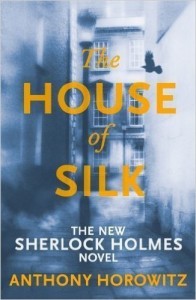 In Bamberg I managed to get some reading done, re-reading Joanne Harris’ Coastliners (supposedly to study objectively how she achieves her great characterisation and sense of place, but of course I got dragged along by the story and stopped paying attention). I also read Anthony Horowitz’s Sherlock novel, The House of Silk, as recommended by DS. I thought the beginning was a little slow but it rattled along at a good pace once I’d got into it.
In Bamberg I managed to get some reading done, re-reading Joanne Harris’ Coastliners (supposedly to study objectively how she achieves her great characterisation and sense of place, but of course I got dragged along by the story and stopped paying attention). I also read Anthony Horowitz’s Sherlock novel, The House of Silk, as recommended by DS. I thought the beginning was a little slow but it rattled along at a good pace once I’d got into it.

Of course, I took notebooks and a couple of writing companions too. I’d finally started my lovely owl project book that Arty Daughter bought me because I thought starting a new novel seemed like a good use for it. The All Big Ideas Start Small is one of my two main ideas books and she bought me that too. I took it along because it had the outlines of two short stories in, but in the end I focussed on my novel and didn’t touch short stories.
As you can see, I took two of my Della Galton books as well – The Short Story Writer’s Toolshed and The Novel Writer’s Toolshed.
The little flowery folder is full of different sizes and designs of sticky notes, from page markers upwards – an ingenious gift from my aunt. Every writer should have one *the folder, not an aunt. They’re not compulsory).
I only had two full days in Bamberg – Techie Husband didn’t have to work on the last day and we could have spent the morning traipsing around Bamberg, but checkout was 11 and it was raining, so we would have had to drag our suitcase and laptop bags around with us in the rain while keeping an eye on the time, as we had to catch a train and tube to Nuremberg airport for our afternoon flight.
 But in those two days, I wrote nearly 5000 words and read many thousands more – and enjoyed a meal out with my husband’s colleagues and two meals with just the man himself.
But in those two days, I wrote nearly 5000 words and read many thousands more – and enjoyed a meal out with my husband’s colleagues and two meals with just the man himself.
Or last meal was Italian and the meal out with his colleagues was traditional German, but our first meal out, when these pictures were taken, was of course at an Irish pub. Because that’s what you do abroad, isn’t it?
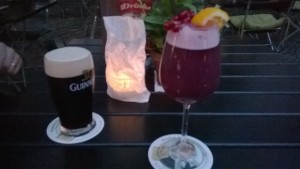 I had cocktails (I hadn’t even started this one, so there’s no excuse for the wobbly hand blurriness) and a very odd crusty salmon dish that was rather overwhelming after the halfway point. It came with hash browns, so the whole meal was unrelentingly and unexpectedly crispy.
I had cocktails (I hadn’t even started this one, so there’s no excuse for the wobbly hand blurriness) and a very odd crusty salmon dish that was rather overwhelming after the halfway point. It came with hash browns, so the whole meal was unrelentingly and unexpectedly crispy.
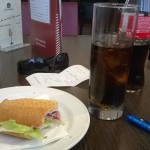
I also had a humble lunch in the hotel bar, in the middle of a furious writing bout, as seen here on the right. (“We have cheese or ham.” “I’ll have ham please.” “Oh, we have something else… salami.”) They do love their parts of pig! I ate my choice of baguette while listening to English songs on German radio interspersed with humorously part-English adverts: “Burger King! German German German Chicken Special Longen!”
 … And a not so humble lunch, on the
… And a not so humble lunch, on the terrace of a rose garden behind The Residence, high above central Bamberg.
terrace of a rose garden behind The Residence, high above central Bamberg.
This little beauty is a flammkuchen. It’s like a pizza, but far lighter and twice as delicious.


I soaked up sun, history and inspiration in equal measure, and got to spend some time with Techie Husband too – and we enjoyed having a meal, just the two of us, as we fail to do this nearly every year on our anniversary. Why? Because we’re usually on holiday with the kids. So it made up for a couple of lost anniversaries.
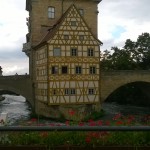 So was it worthwhile?
So was it worthwhile?
Abso-flamin-lutely (which is apparently now in the dictionary. Hooray!). I came back with renewed enthusiasm, no longer feeling my fiction brain was ‘ossified’ as Nicola Morgan puts it!
I’ll be going next time, if I can… 😉
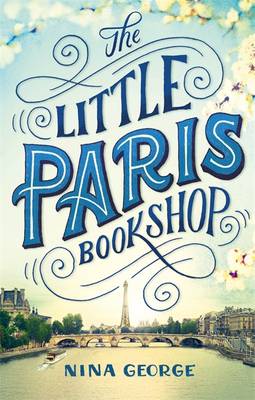

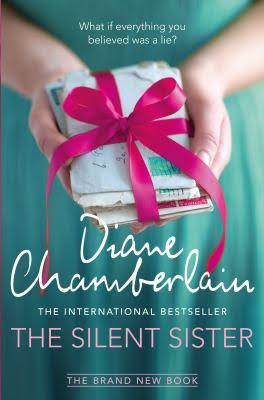
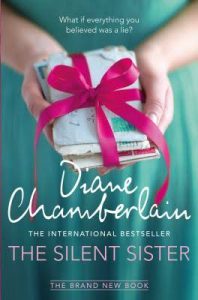



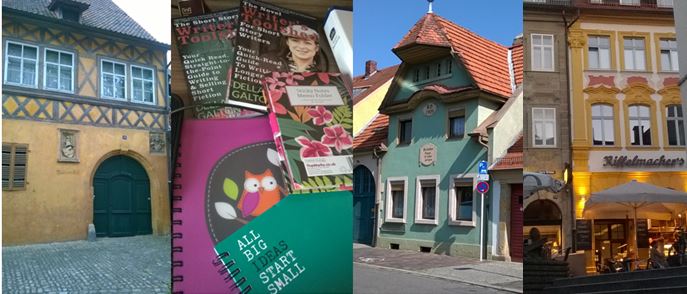











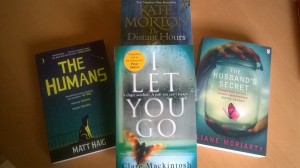
![By Robin Zebrowski (Terry Pratchett, Powell's) [CC BY-SA 2.5 (http://creativecommons.org/licenses/by-sa/2.5)], via Wikimedia Commons File:Terry Pratchett at Powell's 2007-cropped.jpg](http://upload.wikimedia.org/wikipedia/commons/thumb/8/8c/Terry_Pratchett_at_Powell%27s_2007-cropped.jpg/398px-Terry_Pratchett_at_Powell%27s_2007-cropped.jpg)
